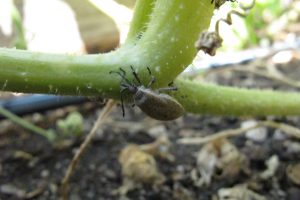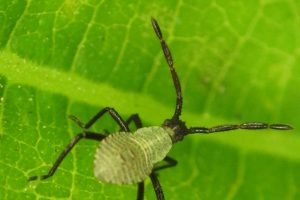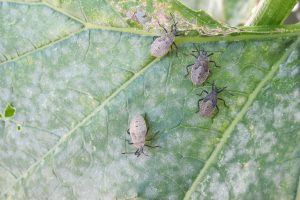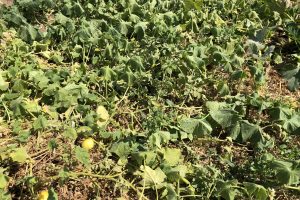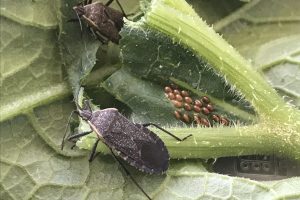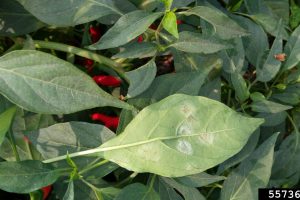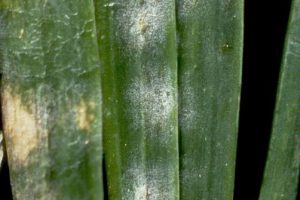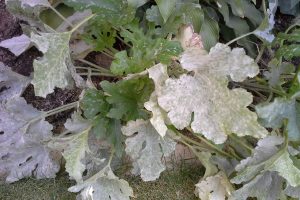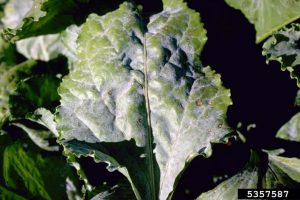In this Issue
- Cucurbits: Powdery Mildew
- Most Vegetable Crops: Powdery Mildew and Wilts caused by Soilborne Pathogens
Squash Bugs
Squash bugs are a primary pest that affects our cucurbit crops (winter squash, summer squash, melons, cucumbers, cantaloupe, etc.). They are capable of causing plant mortality. Utilizing piercing-sucking mouthparts, they extract substantial quantities of plant sap. Notably, in Utah, these insects do not transmit plant diseases.
Adults measure 5/8 inch in length and have wings folded flat over their backs. When disturbed, they emit a foul odor, leading some to refer to them as “stink bugs mistakenly”; however, true stink bugs belong to a different insect family. There are five nymph stages of squash bugs, ranging from reddish to green-gray. Their eggs are shiny bronze and are typically located on the underside of leaves.
Squash bugs overwinter as adults in sheltered locations such as plant debris, compost piles, and around building foundations. They emerge in the spring, typically in April in southern Utah and May in northern Utah, and fly to host plants to feed, mate, and lay eggs. Each female can lay up to 250 clusters of 4-40 eggs on the undersides of leaves. The eggs hatch into nymphs, which take 4 to 6 weeks to mature into adults. The summer generation of adults appears in late July in northern Utah, and 3 to 4 weeks earlier in southern Utah. They feed on cucurbit hosts to build up fat reserves for overwintering.
Look for symptoms such as scars, desiccated and sunken areas on fruits, wilting foliage during the day (due to xylem and phloem disruption) with recovery at night, and complete plant decline.
One of the most crucial strategies for managing squash bugs is to reduce their population through diligent monitoring and removal of eggs. In the spring, inspect plant debris and perennial plants for adult squash bugs. Regularly check the undersides of leaves for eggs.
- Remove or kill eggs using duct tape to remove eggs, smearing eggs with petroleum jelly, or cutting out the section of the leaf with eggs.
- Physically remove adults and nymphs by hand and drown them in soapy water.
- Pull out plants right after harvest to remove overwintering sites for adults.
- Rotate with non-cucurbit crops to minimize the population of overwintering adults.
- Plant cucurbit varieties researched to have resistance to squash bugs, such as butternut and royal acorn squash.
Adult squash bugs exhibit some tolerance to insecticides due to their body structure and ability to hide deep within the plant canopy. Therefore, if you choose to spray, it is best to begin shortly after the egg hatch to target the more vulnerable nymphs. To be effective, insecticide sprays must penetrate the plant canopy and thoroughly cover the tops and undersides of leaves, as well as fruits and vines. Avoid spraying during the day when plants are blossoming to prevent harm to pollinators.
More Information:
Powdery Mildew in Vegetables
Powdery mildew is prevalent in Utah and affects various vegetable, fruit, and landscape plants. Several species of powdery mildew fungi exist, each typically targeting a single host or closely related plant families. These fungi are “obligate parasites,” meaning they require a living host to grow.
| Powdery Mildew Species | Host Crops |
| Erysiphe cruciferarum | broccoli, cabbage, cauliflower, kale, and Brussel’s sprouts |
| Erysiphe polygoni | chard, beet, and beans |
| Erysiphe pisi | pea |
| Erysiphe heraclei | carrot and celery |
| Golovinomyces cichoracearum | cucumber, melon, summer squash, and winter squash |
| Podosphaera xanthii | cucumber, melon, summer squash, and winter squash |
| Leveillula taurica | onion, pepper, and tomato |
Late in the growing season, powdery mildew fungi reproduce sexually, forming chasmothecia on foliage, which contain overwintering spores resistant to cold and drought. In spring, these structures release spores that initiate primary infections in suitable hosts.
Powdery mildew spores can germinate without moisture. Once on a host, they form hyphae that colonize the leaf surface, with haustoria penetrating host cells for nutrient absorption. Within 7 to 10 days, white mycelium and spores (conidia) appear. This high conidia production leads to multiple secondary infections throughout the season. Warm, dry conditions (75–85°F) and high evening humidity can result in rapid spread and potential epidemics, especially in older foliage and densely planted crops.
Early detection of powdery mildew is essential, so regular scouting of plants is important. Commercial growers should randomly select 5–10 locations in the field weekly to check for the disease, while home gardeners can inspect all their plants. Priority should be given to examining the tops and undersides of older, mature leaves, particularly in densely planted areas, locations crowded with weeds, and regions that are vigorously growing or shaded.
To effectively manage powdery mildew and minimize yield loss, proactive measures are essential:
- Plant Resistant Varieties: Choose vegetable crops labeled with varying levels of resistance to powdery mildew. Note that Podosphaera xanthii has several races, and resistant varieties may not be effective against all races, which are not fully identified in Utah.
- Remove Infected Plant Material: After harvest, remove or plow under infected plant debris, as powdery mildew overwinters in these materials. Destroy all infected parts, including leaves, branches, vines, and fruit, and avoid composting them, as composting temperatures are insufficient to kill the pathogen.
- Increase Plant Spacing: Proper spacing between plants improves air circulation, reducing canopy humidity and the risk of powdery mildew infections.
- Irrigate in the Morning: Morning irrigation allows excess moisture to dry from the ground and leaves, lowering evening humidity levels. Whenever possible, switch to drip irrigation to further minimize moisture accumulation.
A variety of fungicides, both organic and synthetic, are available for commercial operations and home gardeners. Fungicide treatments should be considered upon the first signs of powdery mildew, with applications repeated every 7–10 days or as specified on the label.
Be aware that certain products and combinations can lead to phytotoxicity (plant injury), including:
- Oils applied at temperatures above 85°F
- Sulfur applied at temperatures above 80°F
- Mixing oil and sulfur or applying them within two weeks of each other.
More Information:
Vegetable Wilting Caused by Soilborne Pathogens
Fusarium wilt and Verticillium wilt are soilborne plant diseases that target vascular tissue, causing similar symptoms in affected plants. These diseases are challenging to manage due to their ability to persist in the soil for many years. Once a plant is infected, no treatment or cure exists, making it essential to focus on preventive and cultural control practices for management.
Both pathogens have a broad host range among vegetable crops in Utah. Fusarium oxysporum is often categorized into formae speciales (f. sp.) based on the specific hosts they infect, with many formae further divided into races (1, 2, 3, etc.) depending on the resistance genes present in the host cultivar. Verticillium dahliae and V. albo-atrum also cause Verticillium wilt, with their respective hosts detailed in the table below.
| Pathogen | Host |
| Fusarium oxysporum f. sp. apii | Celery |
| Fusarium oxysporum f. sp. asparagi | Asparagus |
| Fusarium oxysporum f. sp. batatas | Sweet Potato |
| Fusarium oxysporum f. sp. betae | Beet |
| Fusarium oxysporum f. sp. cepae | Garlic, Onion |
| Fusarium oxysporum f. sp. ciceris | Chickpea |
| Fusarium oxysporum f. sp. conglutinans | Broccoli, Brussels Sprouts, Cabbage, Cauliflower, Kale |
| Fusarium oxysporum f. sp. cucumerinum | Cucumber |
| Fusarium oxysporum f. sp. cucurbitae | Squash (Summer and Winter) |
| Fusarium oxysporum f. sp. lactucae | Lettuce |
| Fusarium oxysporum f. sp. lycopersici | Eggplant, Pepper, Tomato |
| Fusarium oxysporum f. sp. melonis | Cantaloupe |
| Fusarium oxysporum f. sp. niveum | Watermelon |
| Fusarium oxysporum f. sp. phaseoli | Bean |
| Fusarium oxysporum f. sp. pisi | Pea |
| Fusarium oxysporum f. sp. spinaciae | Spinach |
| Fusarium oxysporum f. sp. tracheiphilum | Pea (black-eyed) |
| Pathogen | Host |
| Verticillium dahliae | Artichoke, Broccoli, Brussels Sprouts, Cabbage, Cauliflower, Cantaloupe, Cucumber, Kale, Lettuce, Squash, Watermelon |
| Verticillium albo-atrum | Beet, Brussels Sprouts, Cabbage, Cauliflower, Chickpea, Kale, Potato, Squash, Watermelon |
The primary symptom of infection by Fusarium oxysporum is wilting, which may not appear until several weeks after infection, allowing young plants to be unknowingly affected. Wilting can occur on one side of the plant, and while younger plants may recover in cooler evening temperatures, older foliage often becomes chlorotic and eventually dies. Over time, especially in hot conditions, permanent wilting and plant death occur, sometimes accompanied by vascular discoloration. There is no treatment once a plant is infected.
Symptoms of Verticillium wilt typically first manifest on the lower foliage, which turns chlorotic and necrotic. In tomatoes, a distinct V-shaped lesion forms on the leaf margins, while in potatoes, symptoms usually begin on the lower leaves. In eggplants, the foliage becomes chlorotic, droopy, and the leaf edges roll inward. Infected plants experience reduced photosynthesis, leading to decreased fruit quality. In severe cases, plants fully wilt and die, often showing discolored vascular tissue.
To identify either wilt disease, remove a dying or recently dead plant along with its roots from the soil. Use a knife to safely cut a cross-section of the stem near the base and examine it for brown discoloration of the vascular tissue. This method can indicate a wilt disease but cannot differentiate between Fusarium and Verticillium infections. An official diagnosis should be conducted by a plant pathologist. Suspected samples can be submitted to the Utah Plant Pest Diagnostic Laboratory for further analysis.
Since infected plants cannot be treated and should be removed, it is essential to implement cultural control practices to prevent the introduction of the disease and improve soil health.
Preventing Introduction:
- Crop Rotation: Rotate between different crops to prevent wilt fungi from accumulating in the soil.
- Source Disease-Free Seed: Although uncommon, uncertified disease-free seeds and tubers may harbor Verticillium spp. or Fusarium spp.
- Maintain Cleanliness: When starting seeds and caring for transplants in a greenhouse, sanitation is critical to prevent pathogens such as Fusarium and Verticillium spp. from being transferred to the field. Sterilize pots and trays by soaking them in a 10–15% bleach solution for 30 minutes to an hour, or use quaternary ammonium compounds. Rinse pots and trays thoroughly with water afterward to avoid phytotoxicity from residue. Disinfect greenhouse benches and other supplies. If infections occur, dispose of seedlings and the potting mix, as it may harbor pathogens.
- Clean Equipment: After working in fields, ensure that workers remove soil from their shoes, tools, and machinery when moving from one field to another.
Where the Disease Has Been Diagnosed:
- Plant Resistant Cultivars: Choose vegetable cultivars with resistance to Fusarium and Verticillium wilts. Cantaloupes, peas, and tomatoes have a wide selection of resistant varieties, while other crops may have limitations. Note that some cultivars may only be resistant to specific races of the pathogen, which will be indicated on the seed packets.
- Dispose of Plant Residues: Remove and dispose of all plant residues at the end of the season to reduce the population of overwintering fungal structures.
- Soil Solarization: Consider soil solarization if the soil can be heated to significant depths (refer to the “Soil Solarization for Gardens & Landscapes” literature from the University of California for specific instructions).
- Soil Fumigation: In commercial production, soil fumigation using high concentrations of metam sodium and chloropicrin can reduce microsclerotia populations in the soil. However, this treatment can be hazardous to overall soil health and may not be economically viable for farmers in Utah.
- Biofumigation: Cover crops in the mustard family have demonstrated biofumigation properties due to their high levels of glucosinolates. Ongoing research on biofumigation is available (consult the “Using High Glucosinolate Mustard as a Cover
Crop to Reduce Weeds and Disease” factsheet from the University of Vermont for further information). - Grafted Plants: Both homeowners and commercial producers can grow grafted plants that exhibit greater resistance. Grafting combines a wilt-resistant rootstock with a scion chosen for its desired fruit qualities. The Estamino and Maxifort tomato varieties are commonly used as rootstocks due to their known resistance.
More Information:

